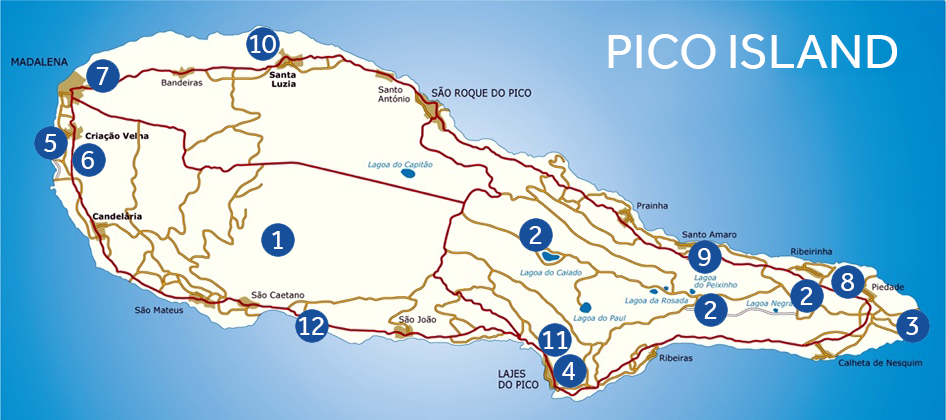
 Mount Pico climbing
Mount Pico climbing
Difficult hike intended for good hikers. We recommend to take a local guide. About 8 hours. Early in the morning, transfer by taxi to the trailhead for the ascent of the “Azores Roof”, 2351 meters, Portugal’s peak, where we will be waiting for the sun to rise, our feet in the warm fumaroles. From the distance, we will make out the islands of São Jorge, Graciosa and Faial. Departure will take place at 1200m, which represents a difference of level of about 1200m
More info : Climb Pico Mountain Bio and Geodiversity
Bio and Geodiversity
Three easy walk (one hour each) for an afternoon of discovery of the Azorean laurel forest (Macaronesian endemic heaths, also called laurisilva) and its's man-made landscape. With someone from the Espaço Talassa team (book on arrival) or with a taxi, you will reach Pico Island east side's highest plateau and “Purgatorio” volcano crater (first walk). Through a land- scape of pasture you will reach “Peixinho” lake (second walk). You will then cross a very dense vegetation to the “Caiado” lake and the “Lagoa Seca” which is surrounded by a cedar forest (third walk).
More info : Volcanoes,lake and endemic vegetation Manhenha-Calhau
Manhenha-Calhau
Easy hike on the seaside. About 3 hours.
From the beacon of Ponta da Ilha, standing at the far south-east of the island where a vineyard landscape lays before you, you will discover François le Potier’s house, surrounded by impressive colonies of terns and shearwaters that took up residence in the basalt cliffs... any takers?
 Walking around Lajes
Walking around Lajes
Easy hike (loop). You will walk past the former whale factory and the look out of Queimada making a loop above the village. Our team can give you some advice about this hike that can take from 1 to 4 hours.
 Criação Velha – UNESCO World Heritage
Criação Velha – UNESCO World Heritage
3 hours easy excursion. One extraordinary voyage to the 18 and 19th century Pico wine grower, who piled up small basalt rocks to build the "Currais”, which UNESCO classified as World Heritage. By running along these walls, it appears that one can touch the moon!
More info : Lava tube and vineyard Cave “Das Torres”
Cave “Das Torres”
With its 5150 meters length, it’s the largest volcanic cavity of Europe. This lava tunnel is also remarkable by the great ceiling height, in certain places more than 15 meters high. Noteworthy also the architecture of the reception facilities: the human intervention was minimized, to let nature express itself freely. Before the visit, a very interesting briefing is presented.
More info : Lava tube and vineyard The Wine & the vineyard
The Wine & the vineyard
The Wine Museum has been installed in a dependence of an old Carmelite Convent. If the collections are relatively poor, the building is strikingly surrounded by a pomegranate grove. Pico is closely linked with the wine history and local memory is still quite alive, especially du- ring vintage period, when the still distils the "Bagaço"!
 Horseback riding
Horseback riding
In Piedade (situated in the eastern coast) you can discover a different Pico... on horseback. The local cheese and the wine are just part of the picnic at Nélia’s “adega” (typical basaltic house).
 Scuba diving
Scuba diving
"There are several diving centres in Pico. It's very difficult to recommend one, because they all offer diving with shark's experiences... which is a questionable activity due to the fact that the sharks are "lured" to the boat, altering their natural state, to satisfy the clients/divers demands."
 Interpretation center of the landscape and vineyard culture of Pico island
Interpretation center of the landscape and vineyard culture of Pico island
This little center offers excursions into the heart of the vineyards of ‘Lagido’ with temporary and permanent exhibitions on those landscapes modeled by human hand, short films... and of course a degustation at the end of your visit.
 Whaler's Museum
Whaler's Museum
Situated about 50 meters away from Espaço Talassa, next to the ‘Whale Come ao Pico’ Hotel, this exceptional museum retraces more than a century of the daily life of the whalers and shows the methods of the traditional Azorean hunt. Its remarkable architecture is designed by Paulo Gouveia.
 Birds & Sea Watching
Birds & Sea Watching
Lajes and the southern coast of Pico are surely one of best spots in the Azores for bird watching at sea and on land as well. We can name the following species as the most commonly watched: Calonectris diomedea (Cory’s Shearwater), Sterna dougallii (Roseate Tern), Tringa nebularia (Common Greenshank), Puffinus gravis (Great Shearwater), Sterna hirundo (Common Tern)... The least commonly watched at sea: Larus atricilla (Laughing Gul), Stercorarius pomarinus (Pomarine Skua), Bulweria bulwerii (Bulwer’s Petrel), Puffinus puffinus (Manx Shearwater)... And the least commonly watched on land: Limnodromus griseus (Short-billed Dowitcher), Podilymbus podiceps (Pied-billed Grebe), Calidris pusilla (Semipalmated Sandpip), Calidris canutus (Red Knot). We can also organize a trip directed towards this type of observation.